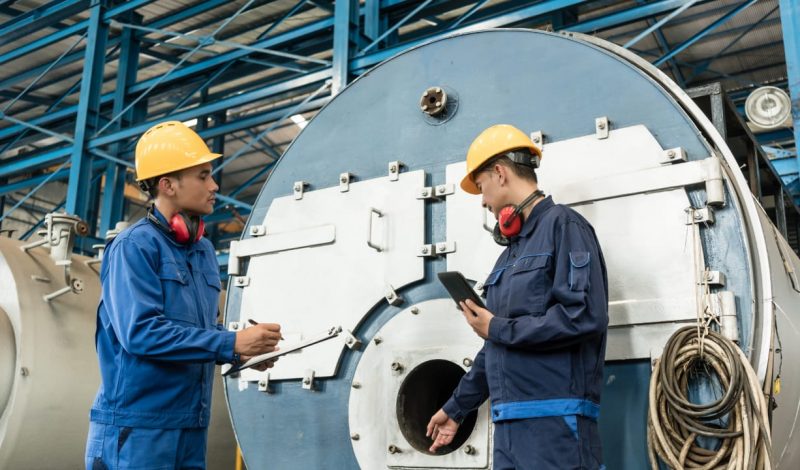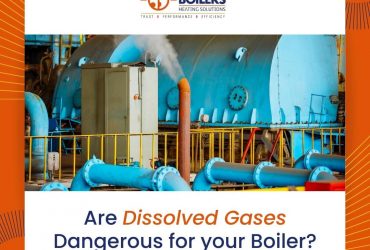Industrial steam boilers plants are used to power a range of processes in many industries. To ensure these industrial boilers systems operate safely and efficiently, it is important to understand boiler terminology.
This article provides an A to Z of boiler terminology, covering definitions of key terms related to industrial steam boilers plants, such as what a boiler is, types of boilers, boiler pressure parts, boiler heat exchangers, and boiler mountings and fittings. Readers will also learn about boiler maintenance and operation and the importance of following safety protocols.
Types of Boilers
When understanding industrial steam boiler plants, it is important to become familiar with their different types and terminology. Several types of boilers are available for commercial and industrial use, each with distinct characteristics.
Fire-tube Boilers:
Fire-tube boilers are a type of boiler in which hot gases from a fire pass through one or more tubes running through a sealed container of water. The heat energy from the gases is transferred to the water, which then vaporizes and passes out of the boiler.
Water-Tube Boilers:
Water-tube boilers are typically used in high-pressure settings and employ tubes that run through a sealed container of water. These boilers are more efficient than fire-tube boilers and can generate up to 25,000 pounds of steam per hour.
Packaged Boilers:
Packaged boilers are pre-assembled and ready to be installed. This type of boiler is ideal for small to medium-sized businesses and is very efficient in terms of fuel and energy usage.
Condensing Boilers:
Condensing boilers are highly efficient boilers that capture the waste heat produced from burning fuel, which is then recycled and used to heat water. This type of boiler is extremely popular in homes and businesses due to its low energy usage and environmental sustainability.
Components of a Boiler System
Some of the important components of the Boiler System
Boiler Pressure Parts
Boiler pressure parts are essential components of any industrial steam boiler plant. These parts include different items such as headers, furnaces, drums, superheaters, economizers, and other necessary items.
The pressure parts help to generate the desired pressure and temperature of the steam, and they help to ensure the proper functioning of the steam boiler plant. It is important to ensure that all the pressure parts are working properly and in good condition to ensure the boiler’s safe and efficient operation. Proper maintenance and inspection of the pressure parts are necessary to ensure their long-term performance.
Boiler Heat Exchangers and Accessories
Heat exchangers are an essential component of industrial steam boilers plants. Boiler heat exchangers transfer thermal energy between two fluids of different temperatures and are typically used in industrial boilers for energy recovery. Boiler heat exchangers come in various shapes and sizes, with common models having horizontal, vertical or shell-and-tube construction.
Accessories such as control and safety systems are also used in boiler heat exchangers, temperature controllers, pressure transducers, and other components. Careful consideration should be given to selecting the correct heat exchanger and its accessories for the specific application to maximize energy efficiency.
Boiler Mountings and Fittings
Boiler Mountings and Fittings form an important part of an industrial steam boiler plant, as they are used to secure the safety of the equipment, personnel and the entire plant. They are an integral part of the boiler, safeguarding the pressure vessel from external damage or overpressure.
Boiler mountings and fittings include the safety valve, feed check valve, air release valve, pressure gauge, and other components. The safety valve prevents any overpressure in the boiler, ensuring that the equipment and personnel stay safe.
The feed check valve acts as a block to the flow of water out of the boiler, while the air release valve is used to release the air trapped in the boiler. The pressure gauge monitors the boiler’s pressure, providing insight into its current condition.
Maintenance and Operation of a Boiler System
The operation and maintenance of a boiler system can be complex due to its intricate inner workings. Regular maintenance and inspections should be carried out to ensure that the system is functioning properly.
Depending on the boiler system, some maintenance tasks may include checking for leaks or pressure levels and adjusting them as necessary. Additionally, operators should be familiar with the system’s safety controls and operating procedures and conduct routine maintenance such as cleaning, lubricating, and replacing worn parts as needed.
By following a strict maintenance schedule, you can ensure that your boiler system is operating at its best and is a safe and efficient means of providing your facility with steam.
Conclusion
A fundamental understanding of boiler terminology can help ensure boiler systems run efficiently and safely. To ensure successful operation and maintenance of boiler systems, it is important to understand boiler terminology and components. Various industrial processes can be integrated with boiler systems, and boilers can be used in a wide variety of industries. Understanding boiler terms is crucial to comprehending the functioning of boiler systems. An understanding of boiler terms can ensure the safe and efficient operation of industrial boiler systems.



